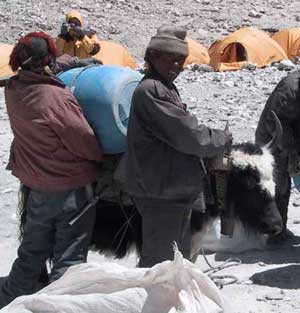The YAK story
Some fun facts about our favourite gear carrier.
In Nepal, especially in the Everest region, many trekkers have seen black furry beasts of burden which they think are yaks. In fact, the majority of these animals are yak hybrids. A cross between yaks and cows, these are dzopkyos; smaller and more docile than the real yaks. They produce more milk and are thus more domesticated than the thoroughbreds.
Over here in Tibet, you get to meet the real yaks – large, often capricious beasts up to a tonne at times. When some hapless trekker’s duffel bag bothers a yak, it is not uncommon to see it bucking and thrashing about until the offending baggage is thrown off. I’ve even seen a duffel being twirled around on a horn tip of an enraged yak. Yak herders are contracted by the various authorities to carry our expedition kit to basecamp or beyond at times. After a harsh winter, the yaks carry less, so post-monsoon expeditions benefit by paying less (since the costs are calculated per yak head).
There is no such thing as yak cheese. Milk comes from female yaks or ” naks” as the sherpas call them. (In Tibet, female yaks or naks are called “dri “.) So technically, the cheese should be called “nak cheese”! In Nepal, you can find factories (I have seen them in Lantang region) producing the cheese, which are up to 10kg in weight and the size of a large basin.
Yak meat is also eaten in various parts of Nepal and Tibet. It tastes like buffalo meat, except it has a stronger odour and takes quite a while to get used to. The meat and soup is very heaty and is good during the winter months or when the trekker gets cold feet.
Yak dung which litter the trails here is often dried and used as a cheap source of fuel. Sometimes, they can be seen decorated on roof tops and side walls of villages. Unfortunately, we find that it burns very inefficiently and produces copious amounts of pungent smoke which definitely takes getting used to!
Ciao,
David and TS

Here, we see the yak herders loading the expedition’s barrels onto a yak. Notice the leading herder’s hold on the horn of the yak (to keep it under control).
Leave a Reply